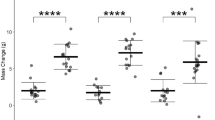Abstract
Two morphometric indices, the destructive index (DI), a measure of alveolar wall destruction, and the proportion of destroyed alveolar attachments to the airways (AA), have been proposed as measures of early lung destruction in human smokers. The aim of this study was to compare DI and AA to the usual measure of airspace enlargement—the mean linear intercept (Lm)—in experimental emphysema. Porcine pancreatic elastase was administered intratracheally to 2 groups of Brown Norway rats (high-dose, n=8, 1 IU/g body weight; low-dose, n=4, 0.7 IU/g; control, n=7). Total lung capacity (TLC), functional residual capacity (FRC) and pressure-volume curves were measured 3 weeks after administration of elastase. Lung elasticity was assessed by chord compliance (Cst). Administration of high-dose, but not low-dose, elastase led to significant increases in FRC and TLC. Cst significantly increased after high-dose elastase compared to controls (p < 0.01). Lm increased after both low-dose and high-dose elastase compared to controls (p<0.01); DI and AA were increased only after high-dose elastase. Significant correlations were found between each morphometric index and Cst; the highest correlation was with AA. Behavior of the morphometric indices in this model differed from that reported in human smokers: Lm was a more sensitive measure of destruction than DI, reflecting a process marked by predominance of airspace enlargement over alveolar septal breaks. These differences from human smokers may result from a differing underlying pathogenesis of lung destruction.
Similar content being viewed by others
References
Bellofiore S, Di Maria GU, Martin JG (1987) Changes in upper and lower airway resistance after inhalation of antigen in sensitized rats. Am Rev Respir Dis 136:363–368
Blackwood CE, Hosannah Y, Keller E, Mandl I, Perman Y (1973) Experimental emphysema in rats: elastolytic titer of inducing enzyme as determinant of the response. Proc Soc Exp Biol Med 144:450
Boren HG (1962) Alveolar fenestrae. Relationship to the pathology and pathogenesis of pulmonary emphysema. Am Rev Respir Dis 85:328–344
Busch RH, Buschbom RL, Smith LG (1984) Comparison of methods for evaluation of experimentally induced emphysema. Environ Res 33:473–496
Cosio MG, Saetta M, Shiner RJ (1986) Alveolar fenestrae in smokers. Relationship with light microscopic and functional abnormalities. Am Rev Respir Dis 133:126–131
Dubois AB, Bedell GN, Bothelo SY, Comroe JH Jr, Marshall R (1956) A rapid plethysmographic method for measuring thoracic gas volume: a comparison with nitrogen wash-out method for measuring functional residual capacity in normal subjects. J Clin Invest 35:322–326
Hogg JC, Macklem PT, Nepsy SJ, Thurlbeck WM (1969) Elastic properties of the centrilobular emphysematous space. J Clin Invest 48:1306–1312
Hoidal JR, Niewoehner DE (1983) Cigarette smoke inhalation potentiates elastase-induced emphysema in hamsters. Am Rev Respir Dis 127:478–481
Janoff A (1985) Protease-antiprotease hypothesis. State of the art. Am Rev Respir Dis 132:417–433
Johanson WG Jr, Pierce AK (1973) Effects of elastase, collagenase, and papain on structure and function of rat lungs in vitro. J Clin Invest 51:288–293
Kaplan PD, Kuhn C, Pierce JA (1973) The induction of emphysema with elastase. I. The evolution of the lesion and the influence of serum. J Lab Clin Med 82:349
Kimmel EC, Diamond L, Winsett DW (1985) Augmentation of elastase-induced emphysema by cigarette smoke. Description of a model and a review of possible mechanisms. Am Rev Respir Dis 132:885–893
Kuhn C, Tavassoli F (1976) The scanning electron microscopy of elastase-induce emphysema. A comparison with emphysema in man. Lab Invest 34:2–9
Morris SM, Snider GL, Stone PJ (1981) Structural changes in hamster lung four hours and twenty-four days after exposure to elastase. Anat Rec 201:523–535
Pump KK (1976) Emphysema and its relation to age. Am Rev Respir Dis 114:5–13
Saetta M, Ghezzo H, Kim WD, King M, Angus GE, Wang NS, Cosio MG (1985) Loss of alveolar attachments in smokers. A morphometric correlate of lung function impairment. Am Rev Respir Dis 132:894–900
Saetta M, Shiner RJ, Angus GE, Kim WD, Wang NS, King M, Ghezzo H, Cosio MG (1985) Destructive index: a measurement of lung parenchymal destruction in smokers. Am Rev Respir Dis 131:764–769
Snider GL, Lucey EC, Stone PJ (1985) Animal models of emphysema. State of the art. Am Rev Respir Dis 133:149–169
The definition of emphysema (1985) Report of a National Heart, Lung, and Blood Institute, Division of Lung Diseases Workshop. Am Rev Respir Dis 132:182–185
Thurlbeck WM (1967) Internal surface area and other measurements in emphysema. Thorax 22:483
Vinegar A, Leith DE, Sinnett EA (1979) Dynamic mechanisms determine functional residual capacity in mice,Mus musculus. J Appl Physiol 46:867–871
Weinberg KS, Hayes JA (1982) Elastase-induced emphysema: asynchronous bronchial, alveolar and endothelial cell proliferation during the acute response to injury. J Pathol 136:253–264
Author information
Authors and Affiliations
Rights and permissions
About this article
Cite this article
Eidelman, D.H., Bellofiore, S., Chiche, D. et al. Behavior of morphometric indices in pancreatic elastase-induced emphysema in rats. Lung 168, 159–169 (1990). https://doi.org/10.1007/BF02719687
Accepted:
Issue Date:
DOI: https://doi.org/10.1007/BF02719687




